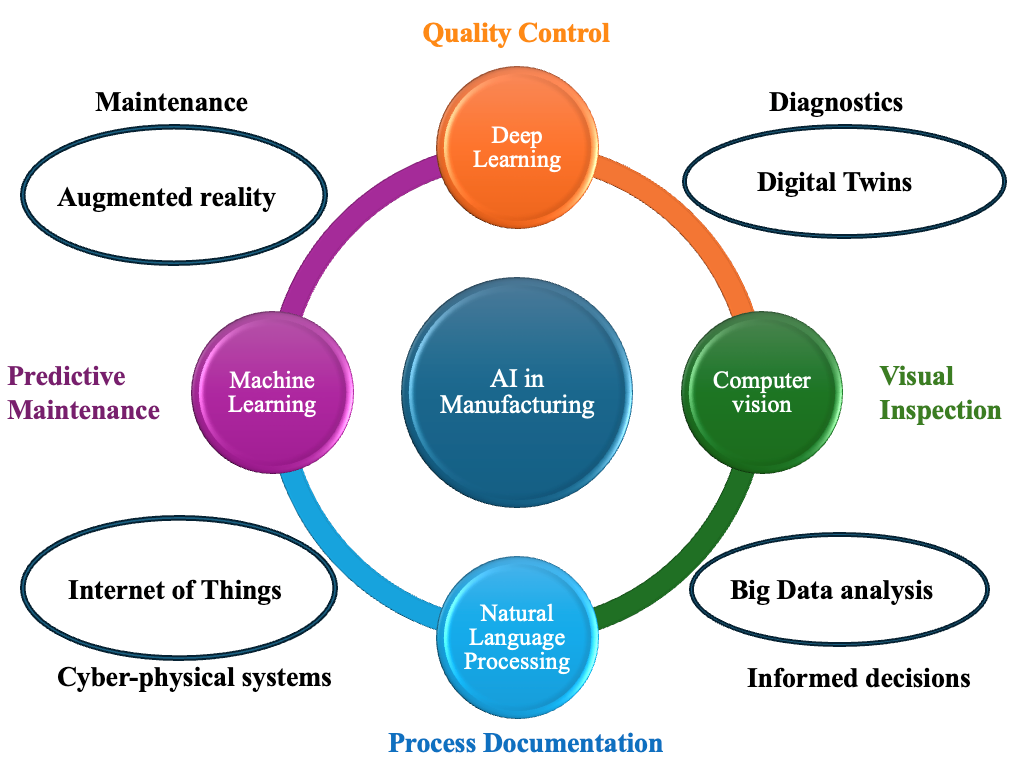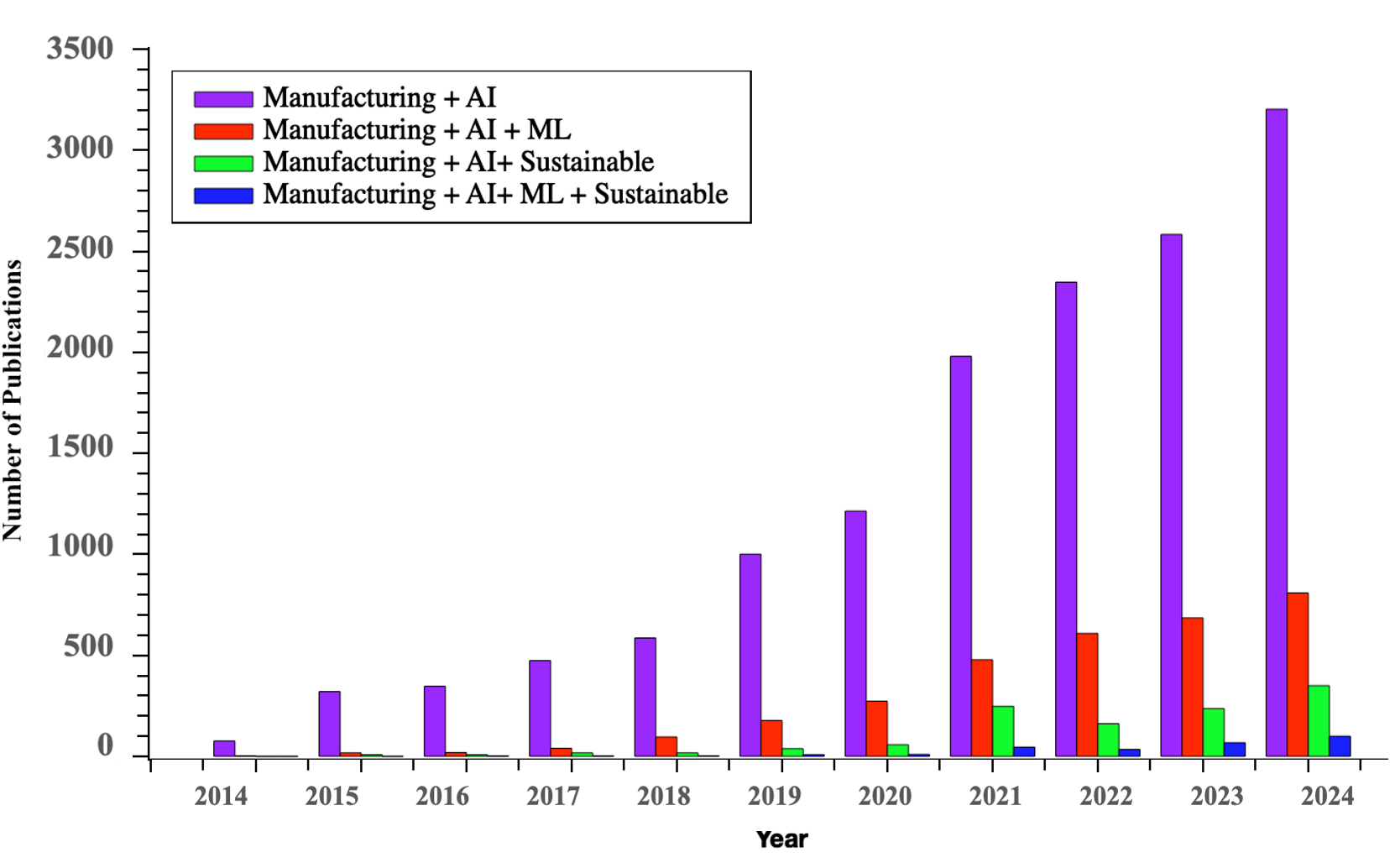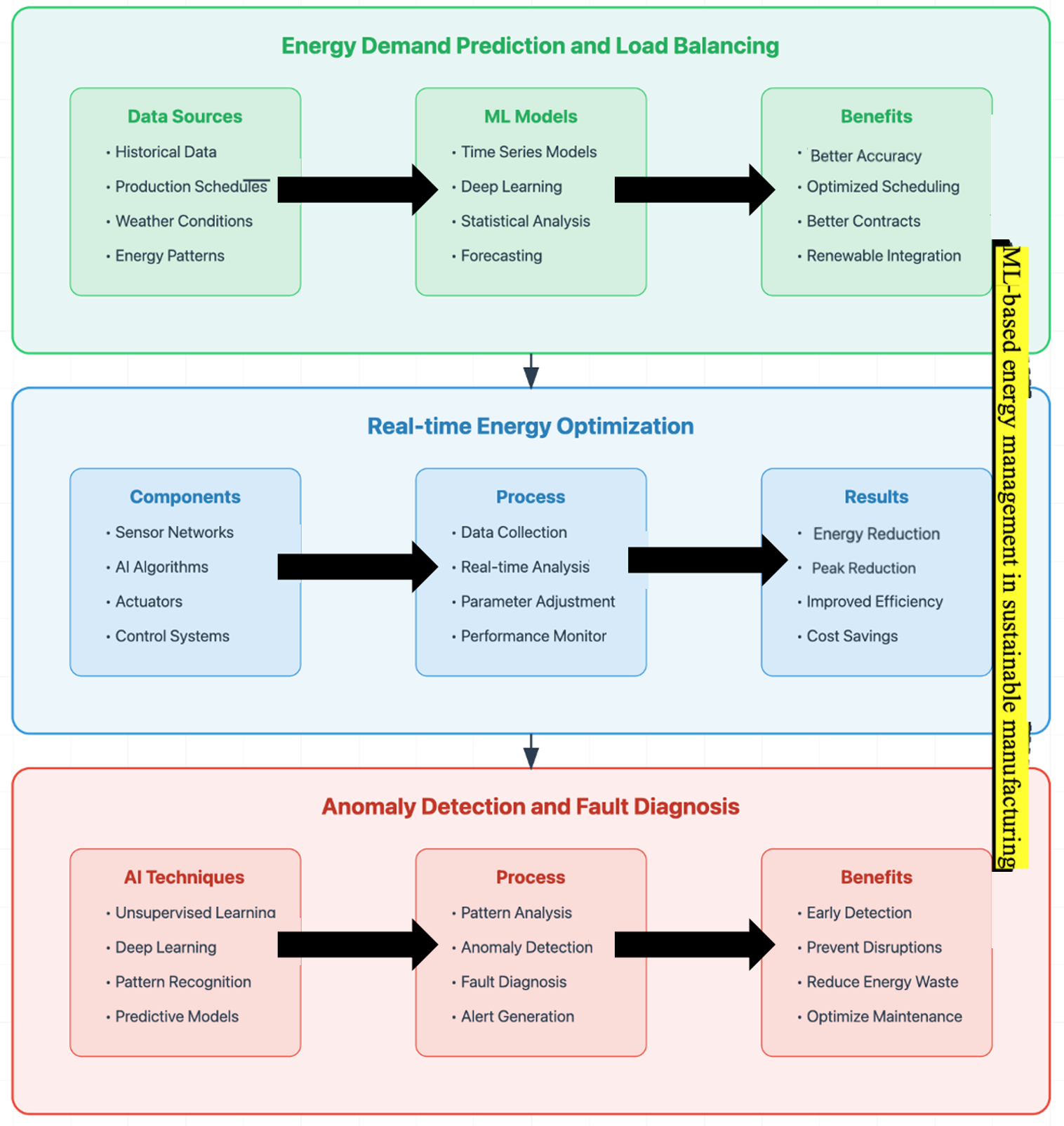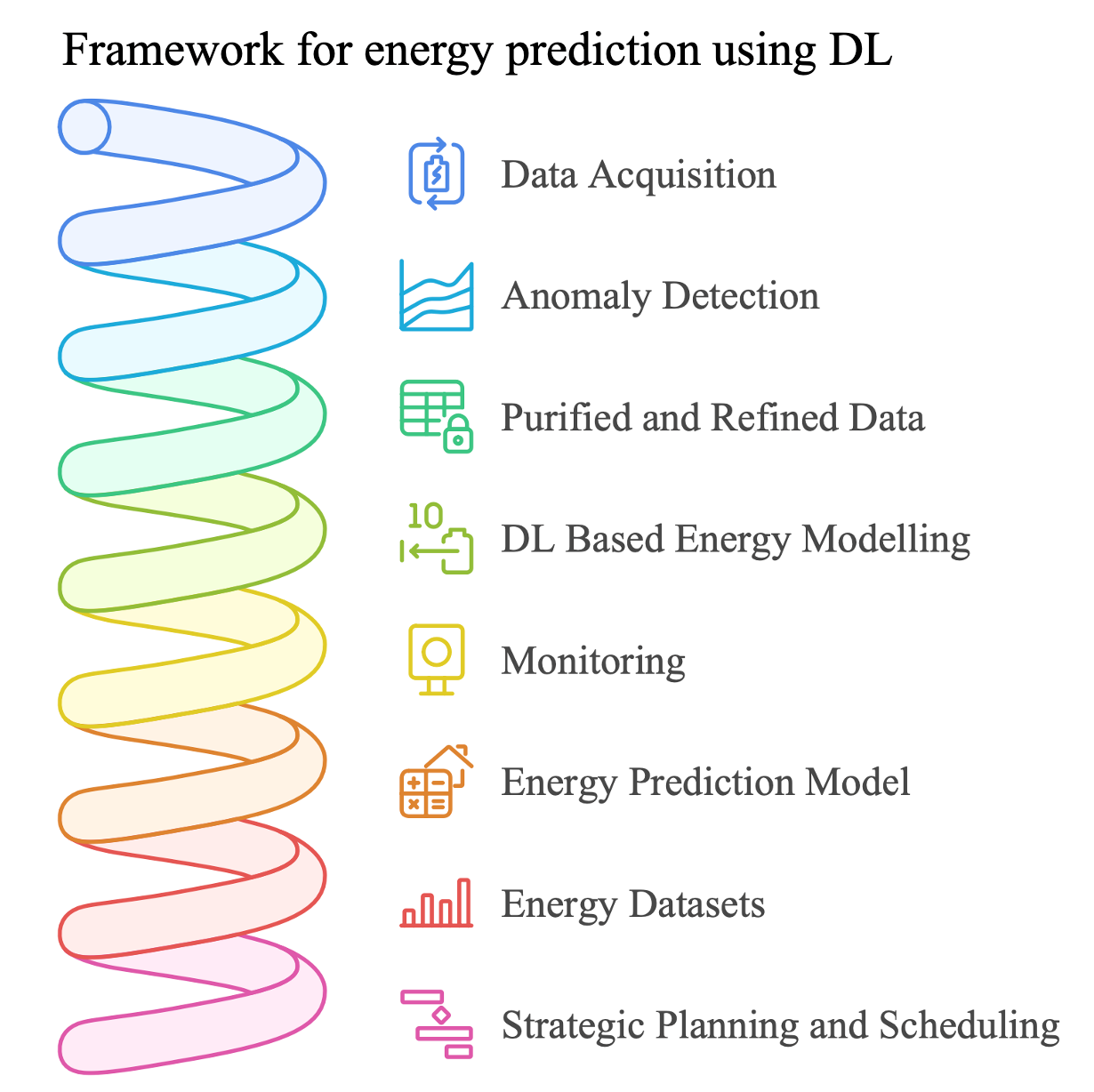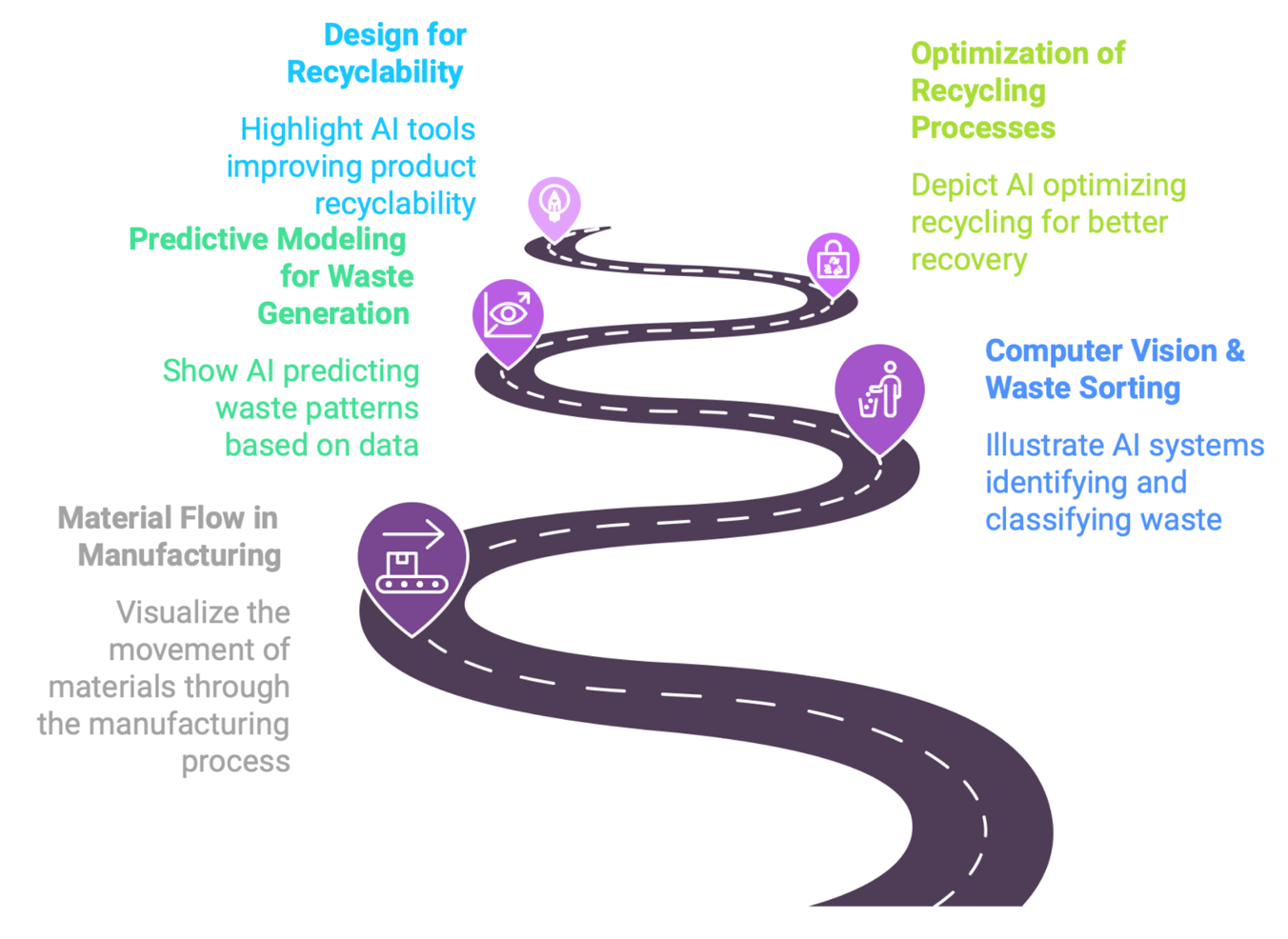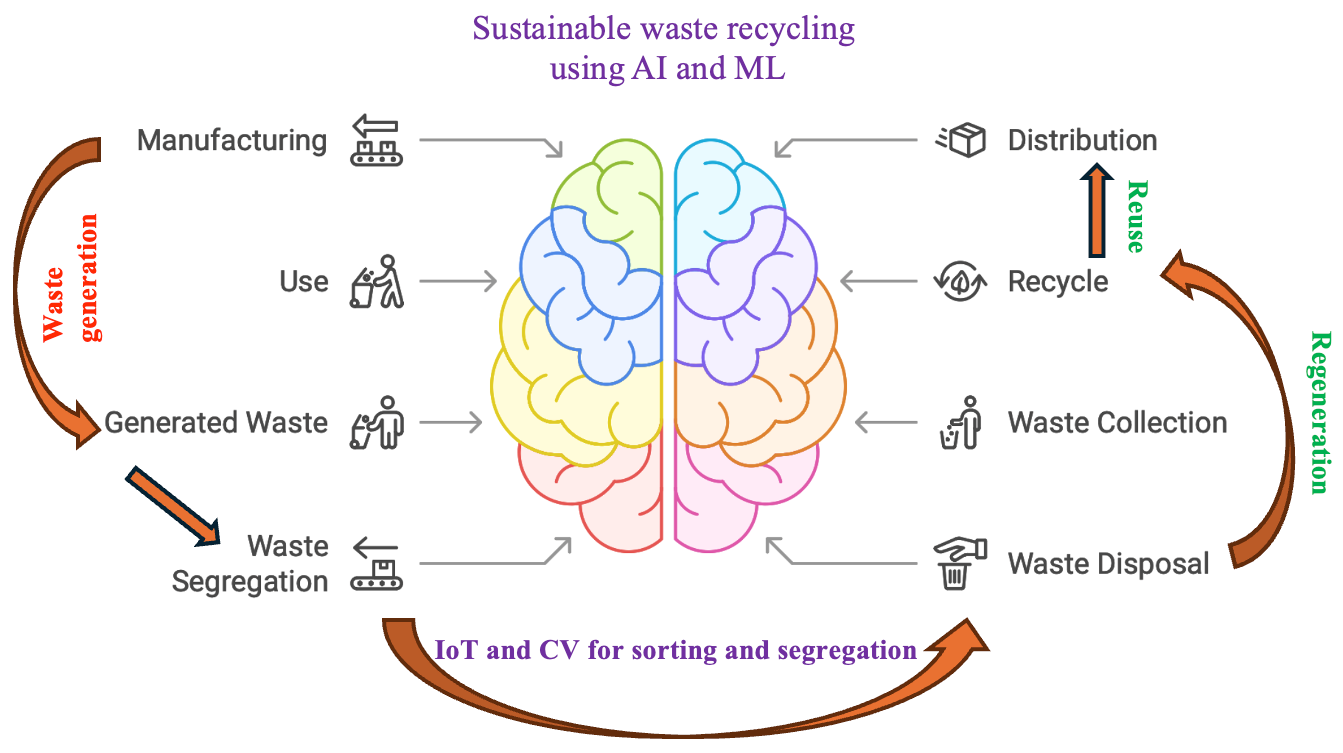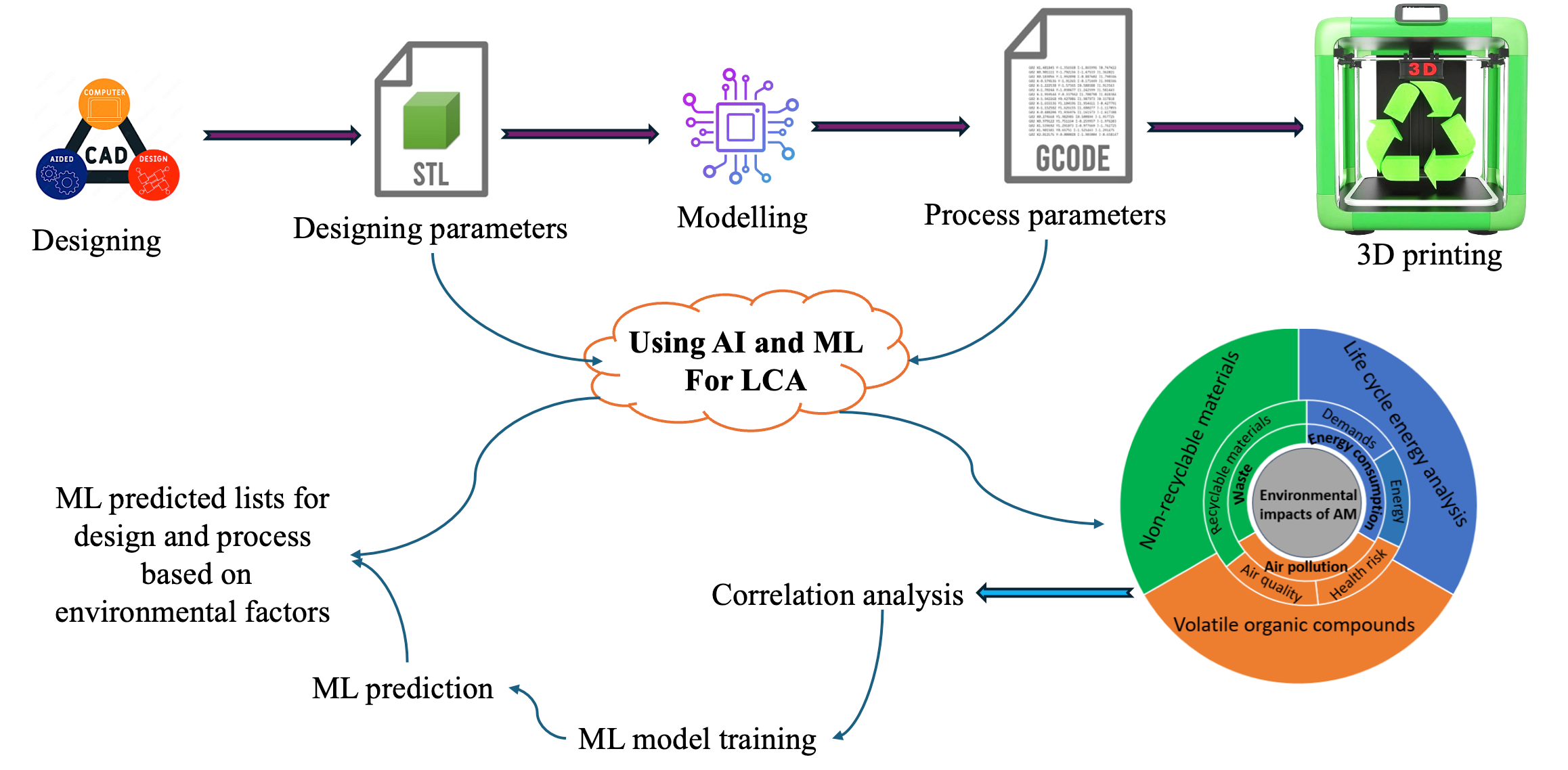The manufacturing sector is at a critical juncture, facing increasing pressure to reduce its environmental footprint while maintaining productivity and competitiveness. Sustainable manufacturing, which seeks to design and develop affordable ways of manufacturing perfect products with proven techniques that have little effect on the environment and use minimal energy and natural resources [
1], has become an important tool that helps deal with these challenges. Simultaneously, the growing development of artificial intelligence (AI) and Machine Learning (ML) technologies has introduced new opportunities to develop manufacturing fields in different branches [
2,
3]. The incorporation of AI and ML into sustainable manufacturing strategies is one of the best ways to foster sustainable development while simultaneously boosting economic success [
4]. Different AI technologies, such as ML, deep learning (DL), and computer vision (CV), provide significant improvements in resource management, minimize waste, increase energy efficiency, and secure a sustainable manufacturing environment [
5,
6].
The advent of AI has heralded a paradigm shift in the manufacturing sector, propelling the Fourth Industrial Revolution, also known as Industry 4.0 [
7]. AI encompasses a diverse array of computational methodologies that endow machines with capabilities traditionally associated with human cognition, including visual perception, speech recognition, decision-making, and language translation [
8]. Within the manufacturing domain, AI technologies are integrated across various facets of production processes, spanning from conceptualization and planning to implementation and quality assurance. The application of AI in manufacturing incorporates multiple interconnected technologies that synergistically enhance production processes. Machine Learning (ML) serves as the cornerstone of this technological framework, empowering systems to autonomously learn and refine their performance based on data analysis, particularly in critical areas such as predictive maintenance and quality control [
9]. As a specialized branch of ML, DL leverages multilayered neural networks to recognize complex patterns, excelling in image and speech recognition tasks critical for manufacturing operations [
10]. CV technology complements these capabilities by analyzing visual data using cameras and sensors, thereby facilitating automated inspection and process monitoring [
11]. Natural Language Processing (NLP) enables effective human-machine communication and analysis of unstructured text data, making manufacturing systems more interactive and intelligent [
12]. Together, these AI technologies have created a comprehensive framework for advancing manufacturing automation and efficiency.
The integration of AI technologies into manufacturing has led to the development of several innovative and intelligent manufacturing frameworks. Smart factories represent a significant advancement, featuring highly connected and digitized production environments that harness AI to optimize operations and dynamically adapt to real-time conditions. These developments are complemented by Cyber-Physical Systems, which create a seamless merger between computational and physical processes by utilizing embedded computers and networks to monitor and control operations through sophisticated feedback mechanisms [
13]. Digital twins further enhance these capabilities by creating accurate virtual replicas of physical assets and processes, leveraging real-time data and AI algorithms to simulate operations, predict outcomes, and optimize performance across the manufacturing ecosystem [
14].
shows how contemporary manufacturing systems have incorporated various AI technologies. These technologies are functional and linked to important manufacturing processes. ML is used in the context of predictive maintenance and interaction with augmented reality, whereas DL is used for quality control. CV supports visual examination and links big data for decision-making. NLP supports process documentation, and the IoT connects to cyber-physical systems. Digital Twins are connected for diagnostics, demonstrating how these technologies can be combined to build an intelligent manufacturing ecosystem. This interconnection structure shows how various AI technologies work in harmony to support manufacturing activities, including maintenance, quality assurance, documentation, and decision-making, which is a new-generation smart factory model.
. AI Technologies in Manufacturing.
The graph depicted in presents a comprehensive analysis of publication trends in manufacturing approaches from 2014 to 2024, focusing on the integration of AI, ML, and sustainable practices across four distinct categories. The visualization demonstrates a significant increase in Manufacturing + AI publications, which dominates the trend with exponential growth from approximately 100 publications in 2014 to over 3000 by 2024, exhibiting particularly rapid acceleration after 2020. Subsequently, the Manufacturing + AI + ML category exhibits moderate but consistent growth, reaching around 800 publications by 2024, indicating increasing interest in combining traditional AI with machine learning in manufacturing processes. Notably, the categories incorporating sustainable practices (Manufacturing + AI + Sustainable and Manufacturing + AI + ML + Sustainable) maintain relatively lower publication numbers throughout the period, suggesting a smaller but steady focus on environmental considerations in AI-enhanced manufacturing. The graph’s vertical axis represents the “Number of Publications” ranging from 0 to 3500, while the horizontal axis spans the decade from 2014 to 2024. This visualization effectively highlights the manufacturing sector’s strong emphasis on AI integration while simultaneously revealing potential growth opportunities in sustainable manufacturing practices. The marked contrast between AI-focused publications and those incorporating sustainability elements indicates a potential gap in research attention that could become increasingly relevant as environmental concerns continue to gain prominence in industrial sectors. The data suggests that while technological advancement in manufacturing is rapidly progressing, the integration of sustainable practices with these technological improvements remains an area for potential future development.
. Publication trends in the area of AI in sustainable manufacturing. (Data obtained from Web of Science with keywords: “AI + Manufacturing”, “AI + ML + Manufacturing”, “AI + Sustainable + Manufacturing”, and “AI + ML + Sustainable + Manufacturing”).
The integration of AI in sustainable manufacturing makes it possible to achieve reductions in environmental impacts, optimize resource utilization, and reinforce circular economy principles. Through the integration of AI in sustainable manufacturing practices, new opportunities have emerged to reduce the environmental impact, maximize resource utilization, and support a circular economy [
15,
16]. Research has also shown potential impacts for sustainable areas like biomedical [
17,
18,
19,
20,
21], water [
22,
23,
24], nanomaterials [
25,
26,
27,
28,
29,
30], Composites [
31,
32,
33], safety [
34,
35],
etc. This section examines some of the key areas where AI is making a significant difference in sustainable manufacturing. Because of the Fourth Industrial Revolution, which is characterized by the fusion of digital, biological, and physical advancements, AI has been identified as a central technology lever in the modernization of manufacturing processes [
36]. The manufacturing sector is under increasing pressure to adopt more sustainable practices due to global concerns about climate change, resource depletion, and environmental degradation. The toolkit provided by AI, which has the ability to handle large amounts of data, identify complicated patterns, and respond to input intelligently and quickly, is powerful in addressing these challenges [
37]. Sustainable manufacturing, as defined by the U.S. Department of Commerce, involves “the creation of manufactured products that use processes that minimize negative environmental impacts, conserve energy and natural resources, are safe for employees, communities, and consumers and are economically sound” [
38]. AI technologies are uniquely positioned to support each aspect of this definition, from optimizing energy use and resource consumption to enhancing worker safety and improving economic outcomes. The applications of AI in sustainable manufacturing span the entire product lifecycle, from design and production to use and end-of-life management [
39]. Applications of AI in sustainable manufacturing include energy optimization through consumption monitoring and efficiency enhancement, equipment longevity via predictive analytics, supply chain network refinement, waste minimization protocols, and lifecycle-oriented product engineering methodologies. Each area represents a critical leverage point for improving the sustainability of manufacturing operations. By harnessing AI technologies, manufacturers can not only reduce their environmental footprint but also drive innovation, improve product quality, and enhance their competitive position in an increasingly sustainability-conscious market. Moreover, the integration of AI with other emerging technologies, such as the Internet of Things (IoT), blockchain, and advanced robotics, creates new synergies and possibilities for sustainable manufacturing. For instance, the combination of AI and IoT enables the creation of “digital twins”—virtual replicas of physical assets or processes that can be used for real-time monitoring, predictive maintenance, and optimization of resource use [
40]. As we delve into each application area, it is important to note that while AI offers tremendous potential, its implementation in sustainable manufacturing is challenging. Issues such as data quality, integration with legacy systems, workforce adaptation, and ethical considerations must be carefully addressed to fully realize the benefits of AI in this domain [
41]. In the following subsections, we explore each key application area in detail, examine current implementations, quantify benefits where possible, and discuss emerging trends and future prospects. By providing a comprehensive overview of AI applications in sustainable manufacturing, this section aims to offer valuable insights for researchers, practitioners, and policymakers working towards a more sustainable and efficient manufacturing sector.
presents a comprehensive analysis of the AI applications in sustainable manufacturing processes and operations. The table systematically categorizes various research initiatives that address critical challenges in manufacturing sustainability through AI methodologies. This systematic compilation provides valuable insights into the current state of AI integration into sustainable manufacturing practices and identifies promising directions for future research and implementation.
. Use of AI in sustainable manufacturing.
Research Problem |
AI Methodology |
Findings |
Ref. |
Energy consumption optimization |
Genetic Algorithm |
Achieved optimal schedule minimizing energy consumption |
[42] |
Cutting tool life prediction |
Neuro-fuzzy logic and support vector regression |
Achieved high accuracy in tool life prediction |
[43,44] |
Production scheduling (electricity & tardiness) |
NSGA-II |
Achieved 4.4% reduction in carbon emissions |
[45] |
Production scheduling (makespan & electricity) |
Ant colony optimization (ACO) |
Demonstrated superior results compared to NSGA-II |
[46] |
Machining process parameters optimization |
Fuzzy logic |
Achieved >95% accuracy in identifying optimal process parameters for green manufacturing |
[47] |
Lean and green concept adoption in smart manufacturing |
Artificial Neural Network (ANN) |
Enhanced firm performance and enabled lean/green production |
[48,49] |
Sustainable scheduling (completion time & energy) |
ACO |
Outperformed NSGA-II in optimization tasks |
[50] |
Optimizing defect rate and operational cost |
Decision tree |
An enhanced decision-making system for optimizing rework procedures in manufacturing |
[51] |
Milling tool condition monitoring |
Support vector machine (SVM) |
Achieved an 85% classification rate for tool replacement guidance |
[52] |
PCB manufacturing order acceptance |
Deep reinforcement learning (DRL) |
Achieved higher prediction accuracy with an eco-friendly acceptance rate |
[53] |
Sustainable scheduling (makespan & energy) |
Whale swarm optimisation |
Achieved 9% reduction in energy consumption and 69% reduction in computation time |
[54] |
Smart manufacturing fault detection |
Convolutional Neural Network (CNN) |
Developed 2D CNN approach for bearing fault detection |
[55] |
Quality prediction in milling |
DL |
Achieved 92.45% accuracy with 93.14% precision |
[56] |
Multi-axis additive manufacturing fault detection |
CNN |
Achieved 98% accuracy in 3D-printed parts fault detection |
[57] |
Supply chain network optimization |
Reinforcement Learning (RL) |
Reduced operational costs by 15% |
[58] |
Enhancing urban renewal efficiency |
Generative Adversarial Network (GAN) |
Reduction in environmental impact and assist factory renovation design |
[59] |
Predictive maintenance for industrial equipment |
Long Short-Term Memory (LSTM) networks |
Improved prediction accuracy for equipment failures |
[60] |
2.1. Applying AI and ML for Energy Management and Efficiency
AI applications, particularly the incorporation of ML algorithms and IoT sensors, have transformed energy management into sustainable manufacturing. These advanced systems provide real-time monitoring and analysis of energy usage patterns across various manufacturing processes, equipment, and facilities. Sophisticated AI models, including deep neural networks (DNN) and RL algorithms, can forecast energy requirements, detect inefficiencies, and autonomously modify operational parameters to enhance energy efficiency.
AI-powered energy management systems have demonstrated significant potential for reducing energy consumption in manufacturing plants, with research indicating reductions of greater than 10–20% [
61]. According to a comprehensive review, the implementation of AI has consistently led to energy reductions exceeding 25% across various applications [
62]. This substantial improvement in energy efficiency can be attributed to the AI’s ability to optimize processes, predict energy demand, and enable more dynamic and responsive energy management systems. For instance, in Chinese manufacturing, incorporating an additional unit of industrial robots per hundred workers leads to an approximately 2.5% reduction in enterprise energy intensity [
63]. Labor-intensive and technology-intensive sectors show more significant reductions in energy intensity than capital-intensive sectors [
64]. Digital twins allow manufacturers to model and optimize energy-consumption scenarios without interrupting ongoing operations [
40]. These technologies are especially potent when combined with smart grid integration, enabling manufacturing facilities to adjust their energy usage flexibly based on grid demand and pricing fluctuations [
41]. Moreover, AI algorithms can enhance production scheduling to capitalize on off-peak energy rates and renewable energy availability, thereby contributing to both cost reduction and environmental sustainability objectives [
65,
66]. Recent case studies from the automotive and chemical manufacturing industries have shown that AI-enabled energy management systems can significantly reduce carbon emissions while maintaining or improving production output.
depicts a comprehensive framework for energy management in smart systems, integrating anomaly detection and diagnosis using unsupervised learning, energy demand prediction through time-series forecasting and historical data analysis, and real-time optimization leveraging sensor networks, AI algorithms, and actuators to enhance efficiency metrics. Time-series forecasting models have demonstrated significant utility in predicting the energy demand within manufacturing facilities with enhanced precision [
67]. These models analyze historical energy consumption data, production schedules, and environmental variables such as meteorological conditions to forecast future energy requirements. This capability enables manufacturers to optimize production scheduling, negotiate more advantageous energy contracts, and effectively plan renewable energy integration. Research has compared six ML algorithms, including ANN, Gaussian regression (GR), and SVM, to predict the power demand and supply in smart grids. Their analysis revealed that these algorithms performed similarly in both quantitative and qualitative measures when optimized, particularly for predictable patterns such as solar PV generation and daily power consumption [
68]. A recent study was conducted over a three-year period from January 2020 to January 2023, using energy consumption data collected from three institutional buildings that had implemented smart building ecosystems. The experimental methodology involved comprehensive data preprocessing, including handling of missing data and feature importance analysis, with statistical evaluation of data normality through skewness and kurtosis measurements. For clarity, we have revised the reporting of our metrics to use more appropriate precision levels: the Boosting Regressor (GBR) model achieved mean absolute percentage error (MAPE) values of 9.3%, 12.3%, and 4.0% Center of Law and Society (CLAS), Nursing and Health Innovation (NHAI), and Cronkite, respectively, while mean absolute error (MAE) values were 71.0 and 53.8 for CLAS and Cronkite. All three buildings were analyzed using three supervised machine learning algorithms: GBR, Long Short-Term Memory (LSTM), and Random Forest (RF), with consistent evaluation metrics applied across all cases to ensure a fair comparison of model performance [
69].
A comprehensive analysis of DL techniques for building energy consumption prediction revealed that memory-based architectures (LSTMs) demonstrate superior performance compared to stateless networks (MLPs) in time-series analysis, even without data aggregation through CNNs. Research conducted on an operational office building, specifically the ICPE facility, indicated that Recurrent Neural Networks (RNNs) achieved a 50% reduction in Normalized Mean Absolute Error (NMAE), whereas CNNs exhibited optimal performance in datasets characterized by missing values and consistent trends [
70]. A study presented a novel DL-based approach for energy prediction in machine tools, demonstrating significant performance improvements with accuracy increasing from 19.14% to 74.13% for grinding machines and from 64.89% to 85.61% for milling machines, compared to conventional handcrafted-feature methods. The innovative methodology, as shown in , employs unsupervised learning for extracting sensitive energy consumption features from raw machinery data, coupled with supervised learning for prediction model development, thereby establishing a more generalized and efficient approach to machine tool energy modelling that requires minimal expert intervention. It is important to note that these predictions are achieved without requiring additional hardware measurements or sensor installations. The model utilizes existing building data infrastructure to generate accurate energy consumption forecasts, making it a cost-effective solution for building energy management systems [
71].
. Framework for ML-based energy management in sustainable manufacturing.
. Framework for energy prediction using DL.
Predictive maintenance powered by AI is revolutionizing equipment management in manufacturing, contributing significantly to sustainability efforts by reducing downtime, extending the equipment lifespan, and optimizing resource use [
72]. A comprehensive study of AI-driven predictive maintenance in U.S. manufacturing revealed that increased AI integration leads to significant reductions in downtime and improved operational efficiency while highlighting the critical role of organizational culture and employee training in successful AI implementation [
73].
provides a comprehensive process flow for AI-assisted predictive maintenance, comprising six key stages. The sequence begins with the identification of maintenance requirements, progresses through the implementation of AI tools and data analysis, advances to maintenance prediction and scheduling, and culminates in execution. This systematic approach elucidates how AI transforms conventional maintenance practices into a proactive data-driven process that enables organizations to anticipate and address equipment maintenance needs prior to the occurrence of failures. Recent reviews indicate that ANN, particularly LSTM and Bi-LSTM architectures, along with random forests, have emerged as predominant methods for industrial equipment performance monitoring and failure prediction, with applications spanning diverse sectors, including the oil and gas, automotive, and coal industries [
74]. A comprehensive review of AI methods for condition monitoring and fault detection of induction motor bearings highlights their critical role in industrial environments, with particular emphasis on various AI techniques, including signal processing, data fusion, and expert systems, for early fault diagnosis and the prevention of catastrophic failures [
75]. A study reported that Deep Forest and Gradient Boosting algorithms achieved an average accuracy exceeding 90% in fault-detection models [
76]. A laser welder predictive maintenance model based on the LSTM-AE algorithm achieved an accuracy rate of 97.3% and detected equipment abnormalities 27 h before failure, reducing downtime by 18 h compared with existing processes [
77]. Random Forest was found to be the most effective in predicting the machine conditions and failure modes for a milling machine [
78]. These AI-driven solutions enable organizations to move beyond rigid calendar-based maintenance routines to more intelligent predictive approaches by continuously learning from historical data and real-time equipment performance metrics. This transformation allows manufacturers to strategically minimize unnecessary maintenance interventions while ensuring that critical equipment receives timely attention, leading to reduced production disruptions and extended equipment lifespans.
. AI-assisted predictive maintenance.
A novel ML-based approach using RL algorithms has shown significant improvements in reducing the downtime and maintenance costs of parallel working machines [
79]. In the aviation industry, a Deep Q-learning algorithm has been successfully employed to optimize long-term maintenance scheduling for aircraft fleets, resulting in fewer scheduled checks and increased fleet availability [
80]. The knowledge-enhanced reinforcement learning (KERL) method was developed for multi-machine systems, achieving higher overall business rewards and learning to avoid failures in stochastic environments [
81].
A study on a real-world use case of semiconductor front-end wafer fabrication showed that RL policies can learn competitive joint scheduling strategies for dispatching and maintenance, considering both internal and external opportunistic opportunities [
82]. Some studies reported even higher improvements in overall equipment effectiveness (OEE). For instance, a case study in the automotive industry demonstrated an OEE increase of over 5% by implementing an AI-enhanced methodology for digital shift-books [
83]. Another study in a manufacturing company showed an improvement in OEE from 54.09% to 60.15% (a 6.06 point increase) by implementing Total Productive Maintenance (TPM) and Single Minute Exchange of Dies (SMED) [
84]. A multinational semiconductor company in the Philippines reported an increase in OEE from 68% to 87%, indicating a 19-point increase [
85].
2.3. Waste Reduction and Recycling Using AI & ML
AI technologies play a significant role in promoting circular economy principles and minimizing the environmental impact of manufacturing through waste reduction and recycling efforts [
22,
86]. In the manufacturing sector, digital technologies, including AI, IoT, and blockchain, enhance visibility, traceability, and collaboration in supply chains, thereby contributing to the implementation of circular economy principles [
87]. AI-driven innovations in waste management include optimizing waste collection routes, automating sorting processes, and enhancing recycling efficiency. ML algorithms analyze historical data to predict waste generation patterns, thereby enabling more effective resource allocation [
88]. Notably, the application of AI technologies in waste management varies between developed and developing regions. In the United States, AI is utilized to optimize advanced waste management infrastructure, whereas in Africa, AI applications focus on scalable and adaptable solutions, such as crowd-sourced waste reporting and smart bins for real-time collection route optimization [
88]. AI technologies are crucial enablers for transitioning to a circular economy model. They facilitate the design of sustainable products, enable new circular business models, and support the broader infrastructure necessary to scale circularity [
89]. Multilayer CNNs have been the subject of research to evaluate the effectiveness of innovative approaches in smart city waste transportation [
90]. Contemporary investigations have explored the application of robotic systems for categorizing recyclable waste from demolition and reconstruction activities, a process that demands precise segregation of various materials before demolition commences [
91]. The adoption of robotic technology has been shown to improve the efficacy of recyclable waste management for resource utilization [
92]. Within this framework, researchers have developed DL models to estimate the volume of recoverable waste materials obtainable from structures prior to their demolition [
93]. The outcomes of these studies indicate the viability of accurately predicting the quantities of waste extracted from a building post-demolition based on its essential characteristics.
presents a comprehensive roadmap for integrating AI into sustainable manufacturing and recycling processes, which is depicted as a winding road with key milestones. The foundational level illustrates the Material Flow in Manufacturing, which focuses on visualizing the movement of materials during the production process. The progression then advances to Predictive Modeling for Waste Generation, wherein AI systems analyze data to forecast waste patterns [
94]. The roadmap encompasses the Design for Recyclability, utilizing AI tools to enhance product recyclability from the conception phase. The trajectory continued to include CV & Waste Sorting, demonstrating how AI systems can identify and classify waste materials. Ultimately, this culminates in the Optimization of Recycling Processes, where AI is employed to maximize the recovery efficiency.
The experimental analysis of garbage classification demonstrated performance variations based on image quality has been studied. High-quality images achieved detection confidence levels approaching 1.0 for common items, whereas complex backgrounds reduced detection reliability. The implementation of GAN-based image enhancement improved the classification accuracy from 89.26% to 91.98%, with kitchen waste detection increasing from 81.82% to 87.88%. These results quantitatively validated the critical role of image quality optimization in waste classification systems. DL models, such as MobileNetV2, EfficientNet, and YOLO variants, have been successfully applied to garbage detection and classification tasks [
95,
96,
97]. The development of region-specific waste databases has proven crucial for improving model performance. For instance, the Taiwan Recycled Waste Database (TRWD) outperformed the commonly used TrashNet dataset when training a YOLO-v3 model for detecting domestic waste specific to Taiwan [
97]. This highlights the importance of tailoring waste sorting systems to the local context. Intelligent waste sorting systems that combine computer vision, DL, and robotics show great promise in automating and improving recycling processes. These systems can achieve high accuracy rates and real-time performance even on embedded devices [
98].
illustrates a circular waste management approach that uses AI and ML. It depicts a continuous cycle of waste generation through detection using IoT technology, device interconnection, collection, data visualization, segregation, and recycling. This advanced approach facilitates efficient monitoring, automated sorting, and sustainable waste-handling practices. The literature has documented the development of an IoT-based digital bin capable of waste disposal management [
99] and air pollutant forecasting in its immediate surroundings [
100]. Concurrently, researchers have explored biogas prediction methodologies using DL models [
101]. Several investigations have focused on predicting industrial waste generation quantities, employing digital research designs that incorporate deep data augmentation techniques [
102] and DL algorithms [
103].
. A schematic roadmap showing the AI-powered waste management and recycling process.
. Circular approach for waste management using AI and ML.
ML algorithms have demonstrated considerable potential in enhancing the efficiency of renewable energy generation from waste recycling. Research indicates that the application of these techniques can reduce energy consumption by up to 30%, increase recycling output, and decrease greenhouse gas emissions. The 30% reduction was calculated based on the aggregate annual energy consumption data, taking into account seasonal variations and normalized for processing volume [
104]. Evolutionary computation, which simulates natural selection to solve optimization problems, has proven effective in identifying high-performance reinforcement-learning policies. These approaches can automatically discover optimal representations, manage continuous action spaces, and address partial observability, in some instances surpassing the performance of traditional temporal difference methods [
105]. Recent advancements have led to the development of adaptive evolutionary algorithms that are specifically tailored to multitask reinforcement-learning environments. For example, the A-MFEA-RL algorithm incorporates crossover and inheritance mechanisms to refine the exchange of genetic material, leveraging the multilayered structure of modern DL-based reinforcement learning models [
106]. This approach has shown competitive success rates across simultaneously addressed tasks and promotes knowledge exchange among synergistic tasks.
The integration of AI, IoT, and blockchain enhances visibility, traceability, and collaboration in manufacturing supply chains, optimizes resource utilization, and reduces waste generation [
87]. These technologies play a crucial role in facilitating the transition towards a circular economy by improving the efficiency and effectiveness of recycling and remanufacturing processes [
107]. The Chemical Production and Waste Material Recovery Framework (CP&WMRF) used an innovative system that outperforms traditional AI-ML approaches in sustainable chemical production and waste management, achieving superior results across multiple metrics, including resource efficiency (97.5%) and waste recovery (98.7%), surpassing AI-ML’s 91.5%. The framework integrates circular economy principles with advanced technologies to transform industrial practices, showcasing how environmentally conscious solutions can be both economically viable and significantly more effective than conventional methods [
108]. AI technologies are making significant contributions to waste reduction and recycling efforts in manufacturing, promoting circular economy principles and minimizing environmental impacts.
AI has transformed product design and lifecycle management through four principal innovations. Generative design tools driven by AI optimize sustainability criteria, resulting in designs that are 25% lighter and 30% more recyclable, as evidenced in automotive components. The implementation of smart product platforming (SPP) powered by AI and generative AI, in conjunction with big data analytics and machine learning, has been demonstrated to facilitate personalized product design and manufacturing suitable for environmentally sustainable products in the circular economy [
109]. This research indicates that SPP and big data analytics are fundamental determinants for manufacturing environmentally sustainable products, ultimately promoting circular economy applications. The integration of ML with Life Cycle Assessment (LCA) has demonstrated its effectiveness in predicting environmental impacts and improving design iterations [
110]. The application of ML in material selection has led to substantial reductions in the environmental footprint, with some studies reporting more than a 20% reduction in almost all environmental impact indicators [
111]. ML algorithms have proven to be valuable tools for enhancing material selection processes, particularly for evaluating environmental impact and recyclability. Their integration with LCA methodologies has led to significant reductions in the environmental footprint, often exceeding 20% [
111].
depicts an AI-enhanced LCA framework for additive manufacturing, illustrating the progression from design requirements through CAD, STL, and G-code generation to the final 3D-printed components. This framework integrates design and process parameters into LCA/LCIA models, employing ML to analyze environmental impacts (climate change, toxicity, ozone depletion, and land use) and to elucidate the correlations between manufacturing parameters and environmental outcomes [
110]. AI also plays a crucial role in low-carbon manufacturing by optimizing production and industrial structures, helping achieve carbon emission reduction targets, and sustainable resource development [
112]. The integration of AI and IoT, forming Artificial Intelligence of Things (AIoT), offers numerous benefits to the manufacturing industry, including improved efficiency, waste reduction, and enhanced safety measures [
113]. The integration of AI across these areas enables manufacturers to create more sustainable products while optimizing their environmental performance throughout their lifespans. In the near future, Artificial superintelligence (ASI) may potentially surpass human cognitive capabilities across all domains, although it remains a theoretical concept, as strong AI has not yet been achieved for a more sustainable future.
. LCA using ML and AI for Additive manufacturing process.
The future of AI in sustainable manufacturing is set to witness remarkable progress across various domains, each holding the potential to transform the sector’s approach to environmental responsibility and operational optimization. A key area of advancement is Explainable AI (XAI), which addresses the existing opacity in AI decision-making processes [
122]. Research has yielded significant strides in this field, introducing an XAI framework for sustainable manufacturing that achieved a 40% enhancement in user trust and adoption rates when compared to conventional black-box AI systems [
123]. This development emphasizes the crucial role of interpretability in building confidence among industry stakeholders, potentially expediting the widespread adoption of AI-driven sustainability initiatives. Another frontier in real-time sustainability optimization for manufacturing settings is the incorporation of Edge AI [
124]. This technology, which brings computational capabilities closer to data sources, presents unparalleled opportunities for swift, energy-efficient decision-making. Edge and fog computing approaches have demonstrated significant latency reductions compared to traditional cloud-based systems. A study reports that their proposed Active Queue Management-based Green Cloud Model (AGCM) for mobile edge computing reduced latency by 84% compared to conventional cloud models and 65% compared to femtolet models [
125]. Reduced latency in edge servers brings significant benefits in terms of energy consumption, although the exact percentage is not specified [
126]. Such a marked improvement in response time may facilitate more flexible and responsive manufacturing processes, enabling instantaneous adjustments to curtail waste and energy usage. AI is also expected to play a pivotal role in advancing the circular economy. The creation of AI-driven material passports and sophisticated algorithms for product lifecycle management is poised to revolutionize resource utilization and waste reduction in manufacturing. AI-enabled tracking of materials and equipment has been shown to reduce waste by over 40%, leading to significant cost savings and environmental benefits [
127]. AI-based models have better prediction abilities compared to other models used in forecasting solid waste generation and recycling [
128]. In 2019, only 17.4% of the world’s e-waste was recycled by formal means, leaving 82.6% untreated or processed informally [
129]. This indicates a significant potential for improvement in e-waste recycling rates, although the paper does not specifically mention AI-driven improvements. A study provided compelling evidence of AI’s potential in this realm, reporting a 40% increase in material recovery rates and a 30% reduction in waste generation within the electronics sector through an AI-powered circular economy platform [
130]. These results suggest that AI could be instrumental in closing product lifecycle loops, substantially diminishing the environmental impact of manufacturing operations. The synergy between human expertise and AI capabilities represents another critical area for future exploration and development. A study involving mixed human-AI teams outperformed human-only teams in an emergency response management scenario, with AI-only teams achieving the highest performance [
131]. Various studies underscored the promise of this collaboration, showing that human-AI teams attained superior environmental performance scores in sustainable product design compared to either human-only or AI-only approaches. This finding points to a future where AI enhances human creativity and decision-making rather than supplanting it, paving the way for more innovative and effective sustainability solutions in the manufacturing industry.
Enhancing supply chain resilience through AI is becoming increasingly significant, particularly in response to recent global disruptions. A study introduced a network optimization model that incorporates both sustainability (via carbon emissions and embodied carbon footprints) and resilience (by considering location-specific risks) [
132]. The adoption of digital supply chain technology as a strategy for improving overall efficiency and operational resilience is currently being studied [
133]. Studies showed that an AI-powered resilient supply chain model not only reduced carbon emissions but also improved supply chain responsiveness to disruptions. This dual benefit of environmental sustainability and operational resilience demonstrates the potential of AI to address complex, multifaceted challenges in manufacturing supply chains. Further exploration of the future application of quantum computing to sustainable manufacturing optimization is promising. Although still predominantly theoretical, the potential impacts are substantial. A study suggests that quantum algorithms could potentially solve facility location-allocation, unit commitment, and heat exchanger network synthesis problems more efficiently [
134]. A study highlights the potential of quantum computing to revolutionize factory optimization, particularly in supply chain management, which could lead to increased productivity and reduced environmental impact [
135]. Studies proposed that quantum-enhanced optimization algorithms could potentially improve energy efficiency in complex manufacturing processes compared to classical methods. Although practical implementations remain a future objective, this research direction underscores the long-term potential of quantum computing to revolutionize sustainable manufacturing practices.
As these research directions progress, it is evident that the future of AI and ML in sustainable manufacturing will be characterized by more intelligent, responsive, and integrated systems. From explainable models that engender trust in edge computing, which enables real-time optimization, to quantum algorithms that address complex sustainability challenges, AI is poised to drive unprecedented advancements in manufacturing sustainability. The realization of this potential lies in continued research, interdisciplinary collaboration, and a commitment to developing AI solutions that are not only powerful but also ethical, transparent, and aligned with long-term sustainability goals.
The advent of AI has heralded a new era in sustainable manufacturing, offering innovative approaches to address long-standing challenges in resource efficiency, waste reduction, and environmental impact mitigation. This comprehensive review examines the diverse landscape of AI applications within sustainable manufacturing, focusing on crucial areas such as energy management, predictive maintenance, waste reduction, and product lifecycle management. The integration of AI technologies across these domains has exhibited significant potential for enhancing environmental performance while simultaneously maintaining or improving economic viability. The influence of AI on sustainable manufacturing is both profound and extensive. AI-powered energy optimization systems have demonstrated the capacity to reduce energy consumption by up to 20%, while predictive maintenance models have successfully extended equipment lifespan by 25%. These advancements underscore the pivotal role AI can play in advancing sustainability initiatives within the manufacturing sector. Nevertheless, the path towards fully harnessing AI’s potential in sustainable manufacturing is fraught with challenges. Issues including data quality, integration with legacy systems, skill gaps, ethical considerations, and the energy consumption of AI systems pose significant obstacles. These challenges, though formidable, also present fertile ground for future research and development. Promising avenues for exploration encompass explainable AI, edge computing, human-AI collaboration, and the application of emerging technologies such as quantum computing. The future convergence of AI with other advanced technologies holds the promise of further revolutionizing sustainable manufacturing. The development of AI-driven circular economy solutions, resilient and sustainable supply chains, and quantum-enhanced optimization algorithms represents merely a fraction of the exciting prospects on the horizon. While AI has already made substantial contributions to sustainable manufacturing, we are likely only at the initial stages of this transformative journey. The way forward necessitates continued research, interdisciplinary collaboration, and responsible implementation to fully harness AI’s potential in creating a more sustainable and efficient manufacturing sector. Achieving an equilibrium between technological innovation and ethical considerations is crucial. The pursuit of sustainability through AI must align with broader societal goals and values. The future of sustainable manufacturing, empowered by AI and Machine Learning, offers immense potential for addressing global environmental challenges while simultaneously driving economic growth and innovation. By embracing these technologies and proactively addressing their associated challenges, the manufacturing industry is poised to play a pivotal role in shaping a sustainable and prosperous future.
The authors express their gratitude to the anonymous reviewers for their constructive feedback, which has enhanced the clarity of this manuscript.
Conceptualization: V.V.K.; Formal Analysis: V.V.K.; Data Curation: V.V.K.; Writing—Original Draft Preparation: V.V.K.; Writing—Review & Editing: V.V.K. & K.S.; Supervision, K.S.
Not applicable.
Not applicable.
The data utilized in this study is available upon request from the corresponding author.
This research received no external funding.
The authors declare that they have no known competing financial interests or personal relationships that could have influenced the work reported in this paper.


